The most commonly used chemical for fixing meiofaunal samples is formalin. The first thing to say is that formalin is toxic and appropriate precautions should be taken when handling it, for example in the laboratory formalin should be handled in a fume cupboard, in the field make sure you are in well ventilated area. In the literature you will find a number of different formulations and concentrations used for fixing meiofauna, I’m going to describe what I use.
My standard method for quantitative sediment samples is 5% formalin, made up using 45µm filtered seawater (preferably from the study site). It is important to filter the seawater to remove the plankton which you do not want contaminating your sample. Some investigators add a borax buffer to the formalin mix, in practice this is not necessary if you plan to process the samples within a few months of collection. Samples should be fixed for a minimum of 4 days before processing. I try to process samples within a few weeks of collection, if only to avoid a growing backlog of samples waiting for processing. If you plan to store the samples over a long period of time (years) then borax should be added. Rose Bengal is also frequently added by meiobenthologists, this dyes the organisms pink making them easier to spot when sorting samples. I personally rarely use Rose Bengal; firstly because I’ve never had a problem locating the meiofauna in my mounted samples; secondly, not all meiofauna are colourless, there are many species that are red, pink, green, black or brown.
Some practical advice for using formalin in the field. As formalin is toxic you do not want to be throwing it around in the back of a small boat or your car, so I go in to the field with a formalin kit which minimises the volume I am carrying about and the amount of time that I have an open bottle with the associated risk of spillages. Firstly, never take the 1L or 4L bottle of Formaldehyde in to the field. If it spills you are going to have a nasty mess, you are contaminating the environment, your car or boat, and possibly yourself; it will be at the very least extremely unpleasant. Calculate before you go to the field to collect samples how much formalin you are going to need. The formalin field kit I use consists of a 500ml bottle for the 5% formalin, and 25ml bottles containing the Formaldehyde (the number of 25ml bottles will depend on the amount of formalin you intend to use). When I require a new batch of 5% formalin the contents of one of the 25ml bottles is emptied in to the 500ml bottle and then filtered seawater is added to make 500ml of 5% formalin. Quick and simple with a low risk of spillages. Finally, you do not need to add the 5% formalin to the sample immediately, if you are working locally and will be back in the lab before the end of the day, it is best to leave adding the formalin until you are back in the lab and can work under more controlled conditions.
I have found over the years that 5% formalin, on the whole, produces nicely fixed specimens. Some groups, like turbellarians, do not react well to a bath in formalin, and most experts in the group prefer to work with live specimens, which can be extracted using techniques such as Uhlig’s seawater ice method. Turbellarians can also be fixed using more complex fixatives such as Bouin’s fluid. In the main 5% formalin produces useful specimens of all the main groups, and I have even found that it preserves more delicate groups like ciliates well enough to be identifiable.
